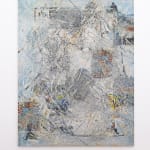-
Artworks
Marcin Dudek
Stadion II, 2022Oil paint, acrylic paint, image transfer, uv varnish, medical tape on wood and aluminium200 x 150 cm
78 3/4 x 59 in.Copyright the artistFurther images
When asked about his 2014 decision to build a multi-million dollar stadium in the tiny village of Felcsút, just 20 meters away from his vacation residence, Viktor Orbán told reporters:...When asked about his 2014 decision to build a multi-million dollar stadium in the tiny village of Felcsút, just 20 meters away from his vacation residence, Viktor Orbán told reporters: “we are doing it for the kids”. Built to accommodate 3800 people, Pancho Arena rarely sees more than 400, though its delicate wooden arches have garnered comparisons to a football cathedral. Named after the legendary player Ferenc Puskás (nicknamed “Pancho” at Real Madrid), the stadium appears more as a monument to Hungary’s authoritarian leader, whose passion for football has been advertised from the start. During his first stint as prime minister, he played semi-professionally on the Felcsút team, and used his influence to attend exclusive World Cup and Champions League finals. In doing so, he inscribes himself into a long lineage of rulers masquerading as athletes; Nero famously participated in the Olympic Games, winning every game he participated in, even the races he couldn’t complete. This conflation of sports and politicians isn’t just about one man’s ego: Orbán has spent the last decade funneling hundreds of millions of dollars into constructing his stadiums, and concentrating the highest political positions in the hands of his former teammates.
In this same interview, Orbán insists- “football belongs to art”. Marcin Dudek takes the suggestion, depicting the making of Pancho Arena and its megalomaniac creator. All the pieces are there- the raw materials, the construction site (with the leader’s cottage conveniently blurred by Google Maps), and most importantly Viktor Orbán himself, who is practically the only character in the composition. He appears at its four corners in a state of repose, with the shifting colours of a chameleon, like the king of a playing card. Near an enlarged, uniformed Orbán, concentric semi-circles of dots and cross-hatched incisions suggest an architectural form, both amphitheatre and parliament. This hybrid is the epicentre of the piece, a formal link between the cultural and political dimensions of Pancho Arena. Here, the stage is set both for vain sports demonstrations and for shady business dealings. In this world, the only person who isn’t Orbán is a worker, photographed by Street View during the building of the site, representing a fraction of the labour mobilised for this wasteful and corrupt endeavour. Behind it all, the stadium multiplying and the map of Felcsút pulsating like a heart, is a rectangle of nothingness. This void is partly covered up by a web of images: flying palettes of pipes and bricks, every penny of the squandered millions rushing in to fill the perpetually empty seats.
Join our mailing list
* denotes required fields
We will process the personal data you have supplied in accordance with our privacy policy (available on request). You can unsubscribe or change your preferences at any time by clicking the link in our emails.


